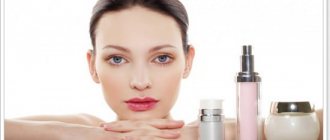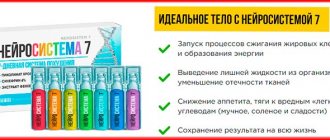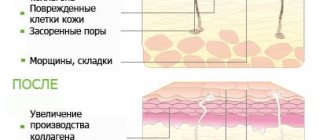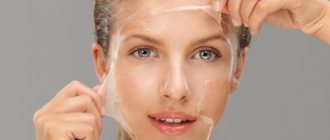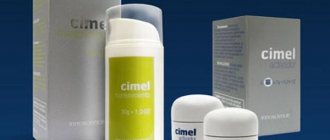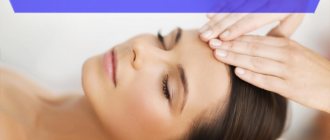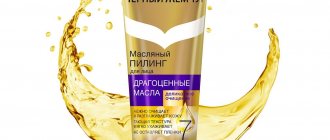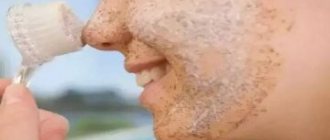Mechanical exfoliants for the face
Facial exfoliants typically consist of small particles and are made from soft substances designed to be gentle on sensitive facial skin. There are a huge number of such funds. These include: exfoliant creams, exfoliant masks, gels, scrubs, peelings, etc.
For most products, the composition includes wax particles (orange or carnauba), paraffin, oatmeal, coconut flakes, soda, algae and their powders (often kelp). During exfoliation, the particles gently exfoliate the surface of the face, removing dead skin, thus activating blood circulation and cell respiration, stimulating the growth of new ones, and the skin takes on a rested appearance and an even tone.
The most widely used for such purposes are exfoliant creams. If you do this procedure regularly, the skin will begin to tighten, the lifting effect will be on the face and face.
WHAT IS IT AND HOW DOES AN EXFOLIANT WORK?
- The broad meaning unites under the concept “EXFOLIATION” all existing skin exfoliation procedures.
- Narrow means only chemical methods of removing dead cells.
For ease of presentation, this article uses the broad concept of exfoliation.
Similar confusion arises between the concepts of “PEELING” and “SCRUB”.
- In fact, peeling is synonymous with exfoliant, so it is important to understand: any scrub is a peeling, but not every peeling is a scrub.
Mechanical body exfoliants
We all know that to maintain youth, the skin of the body also requires additional care. Yes, if you are slim, then you are guaranteed attention, but it is tightened and healthy skin that testifies to your beauty and youth.
Body exfoliant is very helpful in solving such problems. The scheme of action of these products is as follows: by stimulating new cells, the skin tone is evened out, it brightens, is toned, and lumpyness is reduced. It should be added that exfoliant scrubs are often used for anti-cellulite massage at home. After it, it is recommended to apply a soothing and moisturizing body oil (lavender, mint and peony oils, etc.).
To develop exfoliants for the body, particles of larger size and solid consistency are used. Basically, such products are made in the form of scrubs and body masks. Often the composition includes:
- Nut shells;
- Seed powder (apricot, peach, grape, etc.);
- Coffee;
- Pumice;
- Salt, sugar, etc.
Exfoliants from brands such as Yves Rocher, Faberlic Air stream, etc. are very popular among girls. with different kinds of compositions. Reviews not only recommend, but also demonstrate the results of their use. Thus, the skin becomes softer and more delicate, acquires elasticity and the relief is evened out.
Expert advice
- Anastasia Zaslavskaya dermatologist, cosmetologist: “Before exfoliation, you should moisturize your skin well for several days. The best time for such procedures is autumn or winter; in summer, ultraviolet radiation can cause unwanted pigmentation. Exfoliation procedures, especially chemical and laser ones, are contraindicated during pregnancy and breastfeeding.”
- Irene Shimshilashvili, makeup artist and author of the telegram channel “Diary of Visagidze”: “You need to gradually and carefully begin active skin care; if you abuse it, you can get allergies and irritation.
Carefully study the recommendations of specialists, start with small volumes, gradually introduce new products. For some of them, the result does not become noticeable immediately, but only after a few months. Listen carefully to your feelings.”
We recommend: Peculiarities of peeling application. How often can you do the procedure on your face?
Mechanical exfoliants with acids
Very often, the Bark cream mask is used as an exfoliating agent. This is a very popular exfoliant with fruit acids. You can read the instructions for use on the packaging, and there are a lot of positive reviews about the product on the Internet.
Exfoliant bark, as stated by the manufacturer, performs the following functions:
- Exfoliation;
- Acceleration of blood circulation;
- Smoothing out wrinkles;
- Restoring elasticity and softness;
- Toning.
The duration of the procedure is selected individually and depends on the type and sensitivity of your skin.
Basically, exfoliants with acids (especially fruit acids) are designed to rejuvenate the entire body. This is why peeling with fruit acids is a very popular procedure in beauty salons. The active ingredients of such products are aimed at dissolving the layer that connects old and new skin cells. Such drugs penetrate into the deepest layers of the epidermis, stimulating the production of collagen and elastane. The result is rejuvenated, rested, tightened skin.
By the way, the most optimal time for carrying out such manipulations is considered to be the cold evening, since newly created cells react both to the components of care products and to the sun's rays.
Characteristics and Features
Exfoliation has several varieties, which differ in the way they affect the skin:
- Chemical is based on the oxidizing properties of organic acids.
- Mechanical uses scrubs and abrasives made from natural ingredients. In the “brossage” technique, the skin is treated with brushes and sponges, and “gommage” removes dead cells using fruit acids.
- The physical one contains ultrasound, laser, cryotechnology (dry ice and liquid nitrogen).
These types of cosmetic procedures should only be performed by trained professionals to avoid causing irreparable harm to your health. - Biological uses enzymes (enzymes). This is a more delicate method compared to the previous ones.
The depth of penetration of the peeling also varies:
- superficial affects the upper keratinized layers of the epidermis, penetration is carried out to a depth of 30–50 microns;
- the middle reaches the papillary layer, the penetration depth is 50–120 µm;
- deep cleanses the skin down to the reticular layer, going 120–200 microns deep.
Chemical exfoliation
Any chemical peeling or gommage affects the dermal layer of the skin with a concentrated solution of acids (AHA acids, salicylic acid, retinoic acid, lactic acid, etc.) or a solution of enzymes.
Although gommage is classified as a chemical exfoliant, it would be more correct to allocate a separate category for it. Since such products should be applied to previously cleansed and steamed facial skin, then leave them for a couple of minutes (the duration is indicated in the instructions for use). When the product dries and forms a so-called “crust”, it must be rolled with wet hands.
As a rule, the gommage contains a low concentration of AHA acid, which removes the upper dermal surface of the skin, during the rolling of which a large number of pellets are formed, acting as massaging particles. By the way, they function in the same way as solid scrub particles. At the same time, body gommages are also similar to them, since by renewing the skin surface, they make it firmer and more elastic, which helps a girl lose weight and effectively fights the hated cellulite crust.
At the moment, cosmetic companies provide a huge number of different types of gommages to choose from. For yourself personally, you can choose a product that is suitable for you both in composition and in accordance with your skin type of face and body. We advise you to consult a cosmetologist about a particular product before purchasing.
Features of the effects of exfoliants on the skin
Exfoliation involves mechanical and chemical effects on the skin. I would like to immediately note their difference and the principles of action of the exfoliants used:
- Mechanical exfoliation involves scrubbing the top layer of skin with abrasive particles. Exfoliant products violate the integrity of the surface, leave invisible scratches and damage unnecessary, dead and healthy cells at the same time;
- Chemical exfoliation – cleansing the skin with acids (fruit, salicylic, glycolic). This peeling option does not affect healthy cells, does not disrupt their structure, the entire effect is aimed at dead particles. The effectiveness of the procedure is high and will delight you with the cleanliness and softness of the epidermis;
- To carry out mechanical exfoliation, products (scrubs) prepared from natural ingredients are used. They act on the surface, have virtually no contraindications and are easily tolerated by the epidermis;
- Chemical agents (exfoliants) have a profound effect, can reach the basal layer of the dermis, sometimes cause complications and have an impressive list of contraindications. After medium, deep cleansing with exfoliants, a rehabilitation period will be required. At this time, the skin needs proper, high-quality care;
- After scrubbing, a slight transformation of the skin is possible, and peeling with acids guarantees complete renewal of the skin, elimination of fine wrinkles and scars;
- An enzymatic exfoliant for the face does not have the ability to penetrate deeply into the inner layers of the epidermis; its components act only on the surface, so in adulthood, with serious skin imperfections, it is unlikely to be suitable.
Which type of exfoliation to choose depends on your own preferences, the condition of the skin and the expected effect. Do not forget about contraindications and rules for the procedure and after care. They are reflected in the final result.
Contraindications for the use of chemical exfoliants
For the following symptoms and diseases, avoid chemical exfoliation:
- Presence of molluscum contagiosum;
- Skin papillomas and warts;
- Manifestation of psoriasis and eczema;
- Active herpes;
- Having a fresh tan or sunburn;
- The presence of microtraumas or impaired skin integrity;
- Allergy to a component of the product.
Frequency and rules of exfoliation?
- For girls who have mixed or oily skin types, exfoliants can be used no more than three times a week.
- It is necessary to use aggressive chemical exfoliants on your own in the form of peeling or gommage products step by step, as indicated in the instructions for the selected product.
- For normal skin types, it is recommended to use scrubs up to twice a week.
- For dry and sensitive skin, these procedures should be performed quite rarely, once every two to three weeks. Aggressive means, in such cases, are prohibited.
